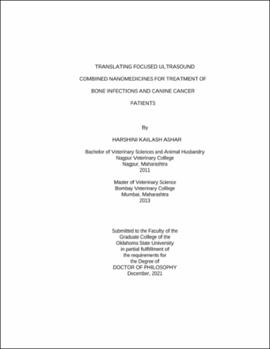| dc.contributor.advisor | Ranjan, Ashish | |
| dc.contributor.author | Ashar, Harshini Kailash | |
| dc.date.accessioned | 2022-05-13T15:26:27Z | |
| dc.date.available | 2022-05-13T15:26:27Z | |
| dc.date.issued | 2021-12 | |
| dc.identifier.uri | https://hdl.handle.net/11244/335732 | |
| dc.description.abstract | High-intensity focused ultrasound (HIFU) is a non-invasive and non-ionizing sonic energy-based therapeutic technology for inducing thermal and non-thermal effects in tissues. HIFU transducers are designed to focus high-energy pulses on a well-defined target region to minimize toxicities to healthy tissues. Depending on the parameters, HIFU can ablate tissue by heating them to >55 degrees C to induce denaturation and coagulative necrosis, improve radio- and chemo-sensitizations and local drug delivery from nanoparticles (NPs) at moderate hyperthermia (~ 41-43 degrees C), and mechanically fragment cells using acoustic cavitation (also known as histotripsy or HT). HIFU has already emerged as an attractive modality for treating human prostate cancer and neuromodulation. Based on this premise, the objective of this doctoral research was to investigate the feasibility of translating HIFU for the treatment of veterinary cancers and bone infections. Veterinary and human patients demonstrate anatomic and physiological similarities, and we hypothesize that HIFU will have a strong promise and translation basis for comparative oncology use. Veterinary research using HIFU can also inform on device innovations needed for human translation against various indications. In this project, we investigated several HIFU parameters to understand efficacy against a variety of veterinary cancers. We also determined immunopathological outcomes to provide the foundations for new treatment protocols. Unlike soft-tissue based tumors, the efficacy of HIFU in treating acoustically attenuating bone tissues that harbor metastasis or recalcitrant biofilm implant-associated osteomyelitis is still unclear. To address this question, a comprehensive assessment of HIFU against established implant-associated bone osteomyelitis was performed. Specifically, the ability of HIFU to induce bacterial killing and improve antibiotic treatments from NPs was determined. Our data from rodent and veterinary cancer studies provided important insights on the opportunities and challenges of HIFU technology, and we believe that the research studies can help jumpstart several clinical trials leading to greater use in patients. | |
| dc.format | application/pdf | |
| dc.language | en_US | |
| dc.rights | Copyright is held by the author who has granted the Oklahoma State University Library the non-exclusive right to share this material in its institutional repository. Contact Digital Library Services at lib-dls@okstate.edu or 405-744-9161 for the permission policy on the use, reproduction or distribution of this material. | |
| dc.title | Translating focused ultrasound combined nanomedicines for treatment of bone infections and canine cancer patients | |
| dc.contributor.committeeMember | Malayer, Jerry | |
| dc.contributor.committeeMember | Ritchey, Jerry | |
| dc.contributor.committeeMember | Piao, Daqing | |
| osu.filename | Ashar_okstate_0664D_17458.pdf | |
| osu.accesstype | Open Access | |
| dc.type.genre | Dissertation | |
| dc.type.material | Text | |
| dc.subject.keywords | bone infections | |
| dc.subject.keywords | canine cancer | |
| dc.subject.keywords | focused ultrasound | |
| dc.subject.keywords | nanomedicine | |
| dc.subject.keywords | osteomyelitis | |
| dc.subject.keywords | veterinary research | |
| thesis.degree.discipline | Veterinary Biomedical Sciences | |
| thesis.degree.grantor | Oklahoma State University | |
